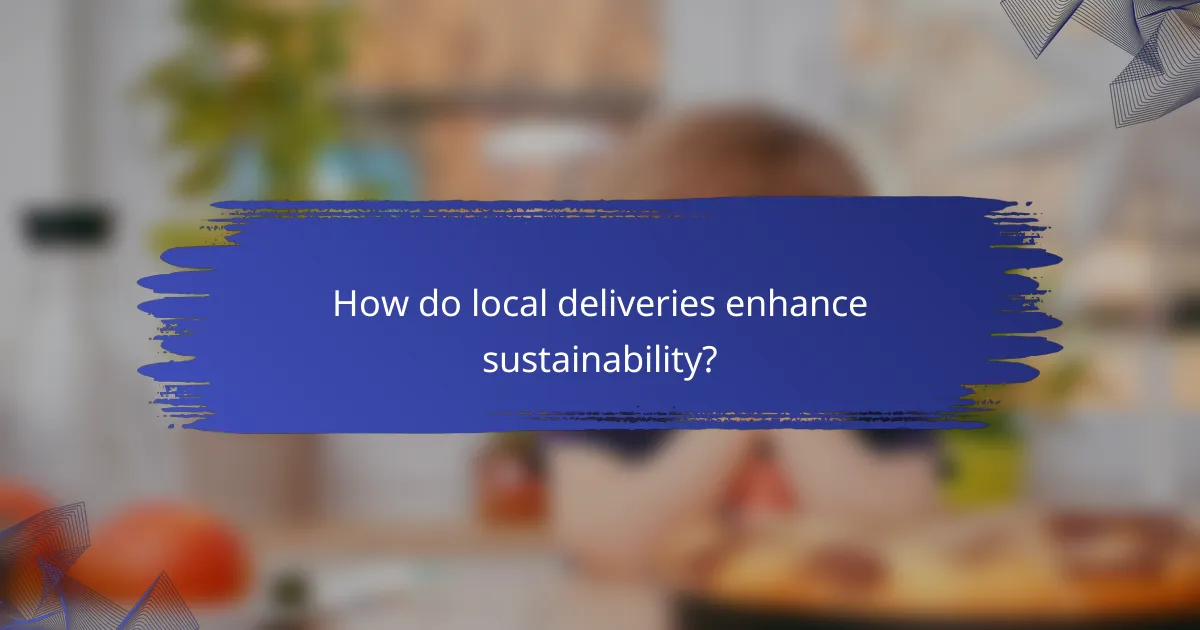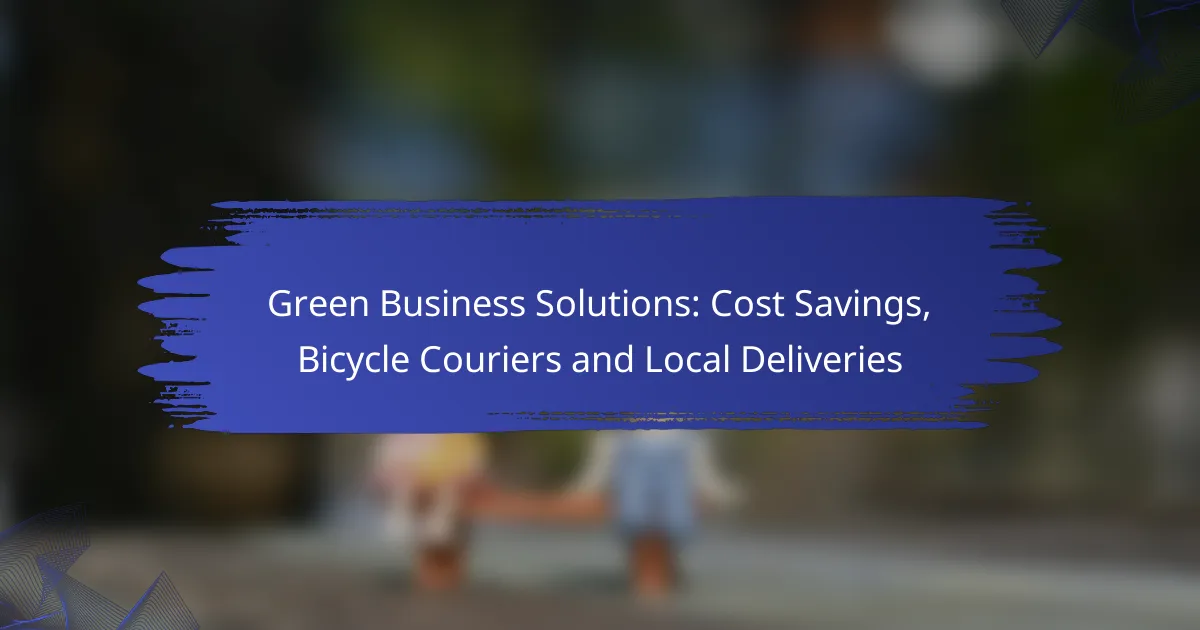Green business solutions present an opportunity for companies to lower operational costs while enhancing their sustainability efforts. By adopting practices such as using bicycle couriers and focusing on local deliveries, businesses can reduce their carbon footprint and improve logistics efficiency, ultimately benefiting both the environment and their bottom line.

How can green business solutions reduce costs?
Green business solutions can significantly lower operational costs by enhancing efficiency and minimizing waste. Implementing sustainable practices not only reduces expenses but can also improve a company’s reputation and customer loyalty.
Energy-efficient technologies
Investing in energy-efficient technologies can lead to substantial cost savings on utility bills. Options such as LED lighting, high-efficiency HVAC systems, and smart thermostats can reduce energy consumption by 20-50% over time.
Businesses should consider conducting energy audits to identify areas where upgrades can be made. Additionally, many utility companies offer rebates for implementing energy-efficient solutions, further lowering initial costs.
Waste reduction strategies
Implementing waste reduction strategies can help businesses cut disposal costs and improve resource efficiency. Practices like recycling, composting, and reducing packaging can significantly decrease waste output.
Companies can conduct waste audits to identify the most significant sources of waste and develop targeted strategies. For example, switching to digital documentation can reduce paper waste and associated costs.
Tax incentives for sustainable practices
Many governments offer tax incentives for businesses that adopt sustainable practices, which can offset costs associated with green investments. These incentives may include tax credits, deductions, or grants for energy-efficient upgrades or renewable energy installations.
Businesses should research local regulations to take full advantage of available incentives. Consulting with a tax professional can help identify the most beneficial programs and ensure compliance with requirements.
Long-term savings from eco-friendly investments
Investing in eco-friendly solutions often leads to long-term savings that outweigh initial costs. For instance, solar panels may require a significant upfront investment but can reduce electricity bills dramatically over their lifespan.
Additionally, sustainable practices can enhance brand loyalty and attract environmentally conscious consumers, leading to increased sales. Companies should evaluate the total cost of ownership for eco-friendly investments to understand their long-term financial benefits.

What are the benefits of using bicycle couriers?
Bicycle couriers offer numerous advantages, including reduced environmental impact and enhanced delivery efficiency. They are an effective solution for businesses looking to optimize logistics while promoting sustainability.
Lower carbon footprint
Using bicycle couriers significantly lowers the carbon footprint associated with deliveries. Unlike traditional vehicles, bicycles do not emit greenhouse gases, making them a cleaner alternative for urban transport.
Many cities are encouraging this shift by implementing bike lanes and infrastructure that supports cycling. Businesses that adopt bicycle couriers can contribute to local sustainability goals and improve their public image.
Faster urban deliveries
Bicycle couriers can navigate through congested urban areas more efficiently than motor vehicles. They can often bypass traffic jams and reach destinations quicker, leading to faster delivery times.
This speed is particularly beneficial for time-sensitive deliveries, such as documents or perishable goods. Businesses can enhance customer satisfaction by ensuring prompt service without the delays often associated with road traffic.
Cost-effective shipping options
Employing bicycle couriers can be a cost-effective shipping solution for local deliveries. Without the expenses of fuel, parking fees, and vehicle maintenance, businesses can reduce their overall logistics costs.
Many courier services offer competitive pricing for bicycle deliveries, often charging lower rates compared to traditional courier services. This can be especially advantageous for small businesses operating on tight budgets.

How do local deliveries enhance sustainability?
Local deliveries enhance sustainability by reducing the carbon footprint associated with long-distance transportation. By utilizing shorter routes and eco-friendly methods, businesses can contribute to a healthier environment while also meeting customer demands efficiently.
Reduced transportation emissions
Local deliveries significantly lower transportation emissions by minimizing the distance goods travel. Utilizing bicycle couriers or electric vehicles can further decrease greenhouse gas emissions compared to traditional delivery methods. For instance, a delivery within a city can cut emissions by up to 50% compared to long-haul trucking.
Businesses should consider implementing route optimization technologies to ensure the most efficient delivery paths. This not only saves fuel but also reduces time spent on the road, further decreasing overall emissions.
Support for local economies
By choosing local deliveries, businesses support their surrounding economies through job creation and increased local spending. When local couriers are employed, the money circulates within the community, fostering economic growth and resilience.
Additionally, local deliveries can encourage consumers to shop from nearby businesses, strengthening the local market. This can lead to a more vibrant community and a reduction in the economic disparities often seen in larger urban areas.
Improved customer satisfaction
Local deliveries often lead to improved customer satisfaction due to faster delivery times and a more personalized service experience. Customers appreciate the convenience of receiving their orders quickly, often within the same day or even hours of placing them.
Moreover, businesses that utilize local delivery services can enhance their brand image by promoting their commitment to sustainability. This can attract eco-conscious consumers who prioritize supporting businesses that align with their values.

What criteria should businesses consider when choosing delivery methods?
Businesses should evaluate delivery methods based on their environmental impact, cost efficiency, and delivery speed. Each of these criteria plays a crucial role in optimizing logistics while aligning with sustainability goals.
Environmental impact
When assessing the environmental impact of delivery methods, consider factors such as carbon emissions, fuel consumption, and packaging waste. For instance, bicycle couriers typically produce significantly lower emissions compared to traditional vehicle deliveries.
Choosing local delivery options can further reduce the carbon footprint by minimizing transportation distances. Businesses can also explore eco-friendly packaging solutions to complement their delivery methods and enhance sustainability.
Cost efficiency
Cost efficiency involves analyzing both direct costs, like shipping fees, and indirect costs, such as potential delays. Bicycle couriers may offer lower operational costs in urban areas due to reduced fuel expenses and parking fees.
It’s beneficial to compare the total cost of ownership for different delivery methods, including any hidden costs. For example, while express delivery might be faster, it often comes at a premium that may not be justified for all shipments.
Delivery speed
Delivery speed is a critical factor that affects customer satisfaction. Businesses should consider the average time it takes for different delivery methods to reach customers. Bicycle couriers can often navigate traffic more efficiently in congested urban settings, leading to quicker deliveries.
However, for longer distances, traditional vehicles may still be necessary. Establishing clear expectations with customers regarding delivery times can help manage satisfaction and reduce complaints.

How can businesses implement green practices effectively?
Businesses can implement green practices effectively by integrating sustainability into their operations and culture. This involves assessing current practices, engaging employees, and collaborating with eco-friendly suppliers to reduce environmental impact and enhance cost savings.
Conducting sustainability audits
Sustainability audits help businesses identify areas for improvement in their environmental practices. By evaluating energy usage, waste management, and resource consumption, companies can pinpoint inefficiencies and develop strategies to minimize their carbon footprint.
To conduct an effective audit, gather data on current practices, set clear sustainability goals, and involve stakeholders in the process. Regular audits can lead to continuous improvement and help track progress over time.
Engaging employees in green initiatives
Engaging employees is crucial for the success of green initiatives. When staff members are involved in sustainability efforts, they are more likely to contribute ideas and adopt eco-friendly practices in their daily work.
Consider creating a green team or committee to lead initiatives, provide training on sustainable practices, and recognize employees for their contributions. This can foster a culture of sustainability within the organization, leading to greater commitment and innovation.
Partnering with eco-friendly suppliers
Partnering with eco-friendly suppliers is essential for businesses aiming to enhance their sustainability efforts. By choosing suppliers that prioritize environmentally friendly practices, companies can ensure that their supply chains align with their green goals.
When selecting suppliers, evaluate their sustainability certifications, such as ISO 14001, and their commitment to reducing waste and emissions. Building strong relationships with these suppliers can lead to better pricing and improved product quality while supporting a greener economy.

What are the emerging trends in green business solutions?
Emerging trends in green business solutions focus on sustainability and efficiency, with businesses increasingly adopting practices that reduce their environmental impact while cutting costs. Key areas include the use of bicycle couriers for deliveries and local sourcing to minimize transportation emissions.
Cost Savings
Implementing green business solutions can lead to significant cost savings. By reducing energy consumption through energy-efficient appliances and practices, businesses can lower their utility bills. Additionally, utilizing renewable energy sources, such as solar panels, can further decrease long-term operational costs.
Another area for savings is waste reduction. Companies that adopt recycling programs and minimize packaging can cut disposal costs and even generate revenue from recyclable materials. These practices not only save money but also enhance a company’s reputation among environmentally conscious consumers.
Bicycle Couriers
Bicycle couriers are becoming a popular choice for urban deliveries due to their low environmental impact and efficiency. By using bicycles, businesses can reduce carbon emissions associated with traditional delivery vehicles while navigating congested city streets more easily.
Employing bicycle couriers can also lead to cost savings on fuel and maintenance. Many cities are now supporting this trend by providing dedicated bike lanes and parking, making it a practical option for local deliveries. Businesses should consider partnering with local courier services that prioritize sustainability.
Local Deliveries
Local deliveries are a key component of green business solutions, as they minimize transportation distances and associated emissions. By sourcing products locally and delivering them within a limited radius, businesses can significantly reduce their carbon footprint.
Moreover, local deliveries can enhance customer satisfaction by providing faster service and fresher products. Companies should evaluate their supply chains to identify opportunities for local sourcing and delivery, which can also contribute to the local economy. Implementing efficient logistics and route planning can further optimize these efforts.










